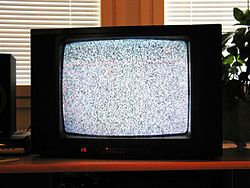Goodbye analog TV
The 12th of June 2009 marked the end for analog television in the Unites States. On that day all American TV stations switched their analog signals off. The Federal Communications Commission (FCC) had decided that analog’s time was over in what could be called a forced upgrade. They are now able to sell the unused frequencies in the analog spectrum, most likely for digital transmissions protocols like mobile broadband.
Can this switch be called historic? I don’t know, but some more relicts of the analog area are going to disappear. After the test card (when TV broadcasting moved to a 24/7 schedule) the next thing from the 20th century to go will be the white screen of static.

The sky above the port was the color of television, tuned to a dead channel.
William Gibson, Neuromancer
This famous opening paragraph sounds very dated now. Glitchy and chopped up playback (as seen with damaged DVDs) have replaced the grainy static snow.
The analog to digital switchover hasn’t really made news - most people I asked were not aware that it happened. I read about it on rhizome.org, a web site dedicated to new media art which commented on the use of YouTube to document the switchover:
There is something curiously surreal about these grainy videos of television screens switching to static, taped in people’s homes on cell phones and digital cameras, only to be posted on YouTube moments later. The novelty of their circulation itself – a historic transition from analog to digital television captured on digital video and then transmitted online – speaks to the media environment we inhabit with accidental precision.
Ceci Moss, Analog to Digital
It’s interesting to see how the last moments of analog TV were featured by the stations: some invited engineers from the “olden days”, some gave background information, others just put a banner and cut in the middle of an advertising block.
I’ve created a little mini-app with 12 YouTube videos showing the last minute of analog TV in the US: endofanalog. You can play clips individually or play them all at once. They’re synchronised so they should all reach the moment of the switchover at the same time, but network delays make this very unreliable. Oh, and a word of warning, playing all clips at the same time looks great but will slow down your system: we’ve come a long way from analog to digital but it’s still impossible to have a dozen clips play at the same time without your computer falling over.